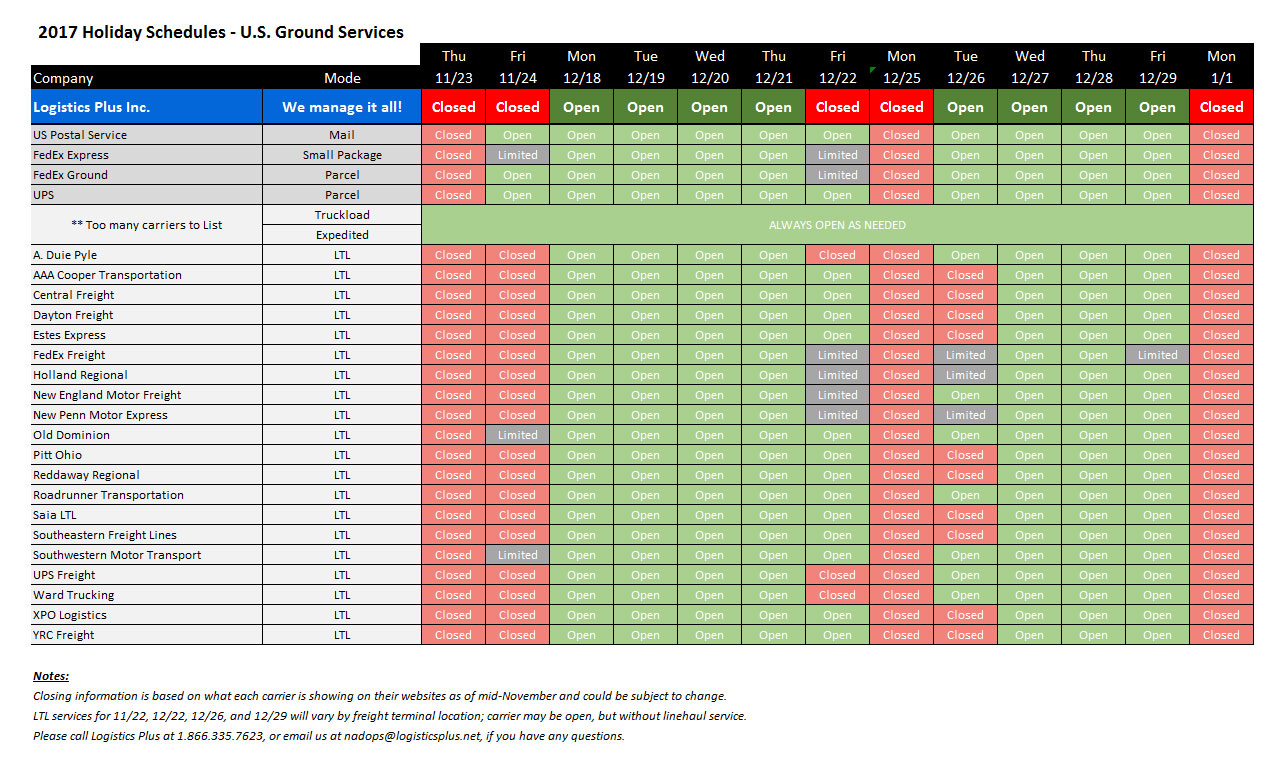
by logisticsplus | Nov 17, 2017 | News
U.S. Holiday schedules for Logistics Plus and ground carriers
As the holidays approach, we want to help you avoid any unnecessary shipping delays over the next few weeks. Shown below is the holiday schedule for U.S.-based Logistics Plus offices and warehouse locations, as well as the top U.S. ground (parcel and LTL) carriers. If you have any special transportation needs, or expedited shipping requests, please contact Logistics Plus in advance of the office closings noted below. You can use the Logistics Plus online global directory to find any of our people or our locations. You can also reach our North American freight division by calling 1.866.335.7623 or emailing us at nadops@logisticsplus.com.

Need help with any last-minute expedited shipping needs? Let us know!

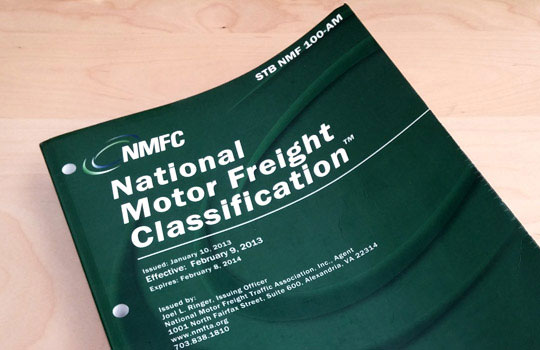
by logisticsplus | Aug 7, 2017 | News
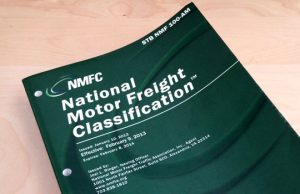 As a reminder, the recently approved National Motor Freight Classification (NMFC) freight classification changes went into effect this weekend (August 5th, 2017). These changes will have far-reaching effects on LTL shipments of certain commodities in the NMFC that are based on density ratings, such as Plastic or Rubber Articles, Expanded, NOI (157320), and others. Previously, most items assigned a class based on density were subject to one of two tables. The so-called 9-tier classification broke down density into 9 sub ratings as follows:
As a reminder, the recently approved National Motor Freight Classification (NMFC) freight classification changes went into effect this weekend (August 5th, 2017). These changes will have far-reaching effects on LTL shipments of certain commodities in the NMFC that are based on density ratings, such as Plastic or Rubber Articles, Expanded, NOI (157320), and others. Previously, most items assigned a class based on density were subject to one of two tables. The so-called 9-tier classification broke down density into 9 sub ratings as follows:
| Sub 1 |
Less than 1 |
400 |
| Sub 2 |
1 but less than 2 |
300 |
| Sub 3 |
2 but less than 4 |
250 |
| Sub 4 |
4 but less than 6 |
150 |
| Sub 5 |
6 but less than 8 |
125 |
| Sub 6 |
8 but less than 10 |
100 |
| Sub 7 |
10 but less than 12 |
92.5 |
| Sub 8 |
12 but less than 15 |
85 |
| Sub 9 |
15 or greater |
70 |
The 11-tier classification contained 11 density breakdowns:
| Sub 1 |
Less than 1 |
400 |
| Sub 2 |
1 but less than 2 |
300 |
| Sub 3 |
2 but less than 4 |
250 |
| Sub 4 |
4 but less than 6 |
150 |
| Sub 5 |
6 but less than 8 |
125 |
| Sub 6 |
8 but less than 10 |
100 |
| Sub 7 |
10 but less than 12 |
92.5 |
| Sub 8 |
12 but less than 15 |
85 |
| Sub 9 |
15 but less than 22.5 |
70 |
| Sub 10 |
22.5 but less than 30 |
65 |
| Sub 11 |
30 or greater |
60 |
Effective August 5th, the 9-tier breakdown will go away and NMFC items subject to it will be replaced by the 11 tier breakdown. This change is actually good news for shippers, as it provides for a lower class for shipments that are very dense, specifically over 22.5 lbs per cubic foot. The other change however is not so favorable. The 11-tier breakdown will change the sub 4 rating for articles that have a density of 4 but less than 6 pounds per cubic foot. Previously this was rated as a class 150, but will now be rated at a class 175:
 For shippers whose LTL shipments were previously rated at class 150 based on density and will now be rated at class 175, this represents about a 15% increase in freight rates. For shippers with an FAK rating of 150, this should not change that rating, but items that were previously in the actual class range may now change. For example, if a shipper has a FAK class 100 rating on items with an actual class of 100-150, and they ship Plastic Articles with a density of 4-6 pcf, this shipment will no longer be subject to the FAK class 100 and will instead move at the actual class of 175.
For shippers whose LTL shipments were previously rated at class 150 based on density and will now be rated at class 175, this represents about a 15% increase in freight rates. For shippers with an FAK rating of 150, this should not change that rating, but items that were previously in the actual class range may now change. For example, if a shipper has a FAK class 100 rating on items with an actual class of 100-150, and they ship Plastic Articles with a density of 4-6 pcf, this shipment will no longer be subject to the FAK class 100 and will instead move at the actual class of 175.
Please contact your Logistics Plus North American Division (NAD) freight representative if you have any questions regarding the new rules.

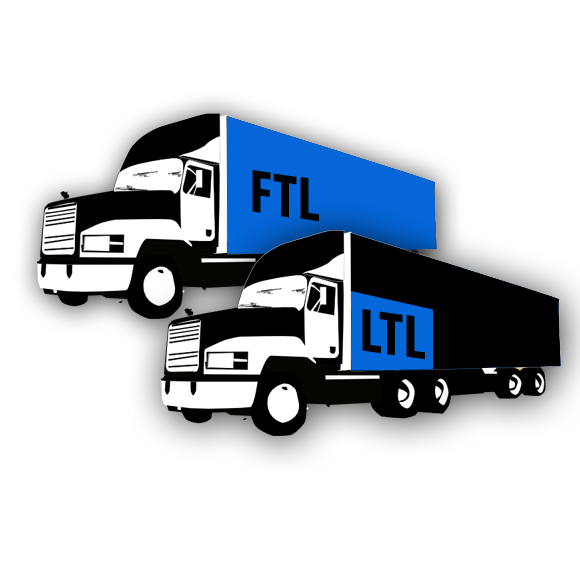
by Marketing | Jul 19, 2017 | News
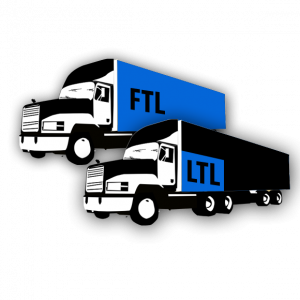 Shipping freight may seem like a very complex process due to the number of options available. It’s important to understand the differences between Full Truckload (FTL) shipping and Less Than Truckload (LTL) shipping because they are two of the most commonly used transportation options within North America. Shippers must consider size, speed, and price when deciding between a FTL versus LTL. Here are the main differences between FTL and LTL shipments to help you decide which shipping method works best for you.
Shipping freight may seem like a very complex process due to the number of options available. It’s important to understand the differences between Full Truckload (FTL) shipping and Less Than Truckload (LTL) shipping because they are two of the most commonly used transportation options within North America. Shippers must consider size, speed, and price when deciding between a FTL versus LTL. Here are the main differences between FTL and LTL shipments to help you decide which shipping method works best for you.
The main differences between FTL and LTL shipments can be broken down into four categories:
Size
The first thing you must take into consideration when shipping freight is the size. The names Full Truckload and Less Than Truckload are self-explanatory and mean exactly what they say. LTL shipments are smaller shipments typically ranging from 100 to 5,000 pounds. These smaller shipments will not fill an entire truck, leaving space for other small shipments. On the other hand, FTL shipments fill most to all of an entire truck and tend to be much larger, often weighing 20,000 pounds or more. Shipments that weigh between approximately 5,000 and 10,000 pounds can sometimes move either LTL or FTL. When such shipments move LTL, they are often referred to as “volume LTL” shipments; and when they move FTL, they are often referred as “partial TL” shipments (read more about Volume LTL and Partial TL here).
Price
Since LTL shipments are smaller and leave room for other shipments, they are cheaper because you will only pay for the space that you use. FTL shipments use most of the entire truck and cost more because you are paying for more space in the truck. The decision between choosing a FTL or LTL is crucial because if you choose the wrong option, you may end up paying for space that you aren’t even using.
Time
If you are pressed on time and need to have something shipped quickly, FTL may be the way to go. Since LTL shipments involve more than just your shipment, they often require multiple stops and transfers before they reach the final destination. Typically, FTL shipments pick up and deliver on the same truck leading to a quicker delivery time.
Handling
Along with how quickly you need a shipment to go out, you must also consider how delicate or high-risk the shipment is. With FTL shipping, your shipment will stay on the same truck and will not be transferred anywhere else. This creates less risk of damaged or missing items when shipping FTL. On the other hand, LTL shipments may switch trucks or be transferred multiple times before delivery, increasing the risk of damaged or missing items.
Choosing the correct shipping method is crucial for saving time and money for your company. If you have LTL or FTL shipping needs, then look no further than Logistics Plus! Contact us today.

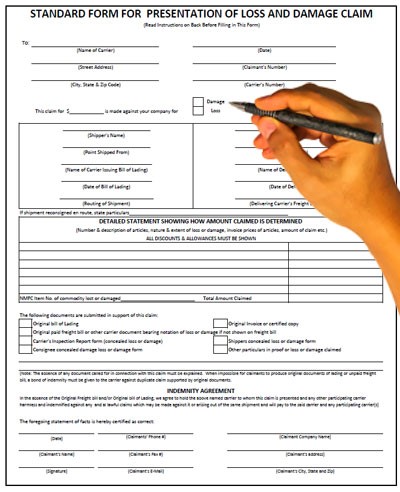
by Marketing | Jun 27, 2017 | News
 Learning how to effectively file a freight claim is important because it will save time and money for your company. A freight claim is a legal demand for the payment of money, stemming from the breach of a contract of carriage. Following specific guidelines and processes is the only way to correctly deal with these claims. There are four essential elements to filing a freight claim:
Learning how to effectively file a freight claim is important because it will save time and money for your company. A freight claim is a legal demand for the payment of money, stemming from the breach of a contract of carriage. Following specific guidelines and processes is the only way to correctly deal with these claims. There are four essential elements to filing a freight claim:
- The shipment must be identified so the carrier can complete an investigation.
- The type of loss or damage must be stated.
- The amount for the claim must be stated.
- A demand for payment by the carrier must be included.
On top of making sure all four elements are included, follow these tips and suggestions to make sure you effectively file your next freight claim:
- Take immediate action
- Taking immediate action is a crucial step of effectively filing a freight claim. Freight claims for loss or damage are generally governed by Title 49, CFR. Claimants must file the claim, in writing, within the time limits specified in the bill of lading or contract of carriage. The time period cannot be more than 9 months (49 USC 14706e) from date of delivery or, if never delivered, the expected delivery date. Unless otherwise agreed upon in a contract, a carrier must acknowledge receipt of a claim within 30 days. The carrier must then pay, offer to compromise or disallow the claim within 120 days or provide status reports every 60 days thereafter. If the carrier fails to abide by these periods, it should be notified that it is violating the FMCSA claim regulations. Furthermore, per the National Motor Freight Traffic Association, concealed damage must be reported to the carrier within 5 days. After 5 days, if the carrier has not been alerted of the damage, they retain the right to deny the claim. The customer then becomes responsible for providing proof that the damaged or missing items were the result of poor actions on behalf of the carrier. If the customer is unable to provide such proof, the claim will be considered invalid.
- Attempt to mitigate the damages
- A responsibility that all parties of the shipping process share is attempting to mitigate damages. It is your responsibility to give a good faith effort to salvage damaged products unless you consider them to be totally or substantially useless and of no good.
- Make supporting documentation available
- Including supporting documentation is necessary for correctly filing a freight claim. If available, you should include the original bill of lading (BOL), the paid freight bill, inspection reports, notification of loss, copies of request for inspection, invoices, waivers, and other appropriate documents such as temperature reports and weight certificates. The more information you have regarding the freight, the more effective your claim will be.
- Create a detailed description of the losses or damages
- A detailed description of the loss or damage should be properly displayed. The claimant should include the number of items damaged, the type of damage, the value of each unit, and the net loss which results in the total amount of the claim. For example:
- 15 boxes of cell phones – (water damaged) @ $500 each: $7,500
- 5 boxes of cell phone cases – (crushed) @ $100 each: $500
- Total Damages: $8,000
- Amount Salvaged: $250
- Total Claim Amount: $7,750
- The role of 3PLs, brokers or intermediaries
- Many shippers use the services of intermediaries such as brokers or 3PLs (like Logistics Plus) to arrange with carriers for the transportation of their goods. Ordinarily a broker or 3PL does not have any liability for loss or damage since it is not a carrier and does have physical possession or control over the shipments. As a value-added service, Logistics Plus will generally offer to handle the filing and/or collection of claims on behalf of our customers. We also make available the various documents shippers need to file claims. This should not be confused with an assumption of liability, however; and claims must still be filed in your name (not that of Logistics Plus).
If you frequently ship LTL freight or truckload shipments, freight losses and damages are almost inevitable at some point during the process. That’s why it’s important to have an experienced and caring freight management partner on your side. When you work with Logistics Plus, we’ll gladly assist you with the filing or processing of your freight claims, and we’ll go to bat for you with the carriers to best represent your interests. Contact us today to learn more.

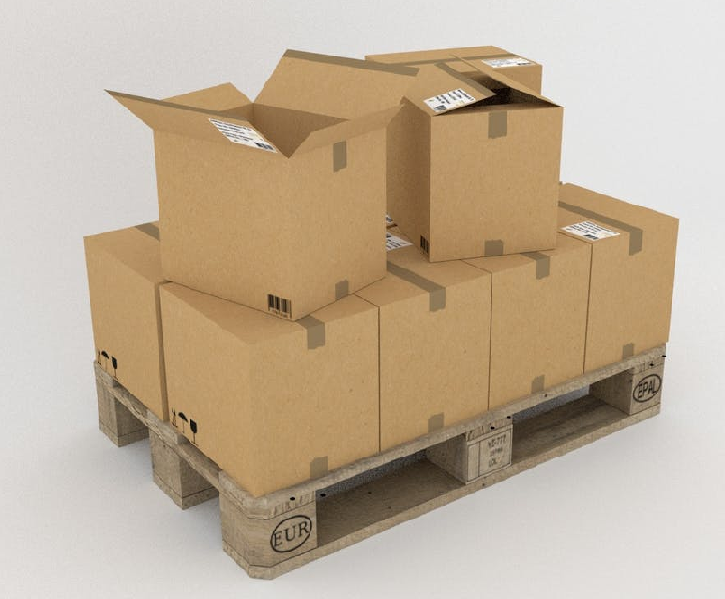
by Marketing | Jun 8, 2017 | News
 When you need to save on LTL shipping, it can be difficult for shippers to find the lowest rate that will fit their shipping needs. LTL (less-than-truckload) freight shipments involve small freight deliveries that are too large to be considered parcels, yet too small to fill an entire truckload. LTL freight shipping rates can be very complex and confusing, but third-party logistics (3PL) providers, such as Logistics Plus, can help ensure you are receiving the best possible rate. Make sure you follow these tips to save the next time you have an LTL shipment:
When you need to save on LTL shipping, it can be difficult for shippers to find the lowest rate that will fit their shipping needs. LTL (less-than-truckload) freight shipments involve small freight deliveries that are too large to be considered parcels, yet too small to fill an entire truckload. LTL freight shipping rates can be very complex and confusing, but third-party logistics (3PL) providers, such as Logistics Plus, can help ensure you are receiving the best possible rate. Make sure you follow these tips to save the next time you have an LTL shipment:
- Know exactly what your shipment is
- It is crucial to be exact when weighing and calculating the size of a shipment. Shippers should never use an estimate for the weight or size of their items because if they are wrong, carriers will charge additional fees that will only increase the cost of your shipment. Also, find out the exact and correct NMFC item number and description for your commodity and make sure it is noted on your bill of lading. Some commodities even have freight density exceptions that can also impact your rates. More carriers are enforcing bill of lading accuracy and avoiding these surprise fees is a very important way shippers can keep their total costs to a minimum.
- Choose the correct freight class
- Understanding freight classifications is important to saving money on LTL shipments. Freight classifications are based mainly on density, but other factors such as liability and handling are also considered. There is a total of 18 standard classes, and choosing the correct one is crucial to avoiding additional fees and costs. A lot of times, these freight classes are negotiable with carriers making it possible to reduce your shipping costs as much as possible.
- Maximize your pallet space
- Most LTL carriers have very specific and often complex cubic capacity rules which can greatly increase the cost of your shipment. Carriers impose minimum cubic capacity rules to effectively counter very light, fluffy shipments that take up more than their fair share of a trailer. In most cases, if a shipment consumes 750 cubic feet of space or more, and the shipment has freight density of less than 6 pounds per cubic foot, it’s not paying its fair share. In these cases, carriers will often default to a higher freight classification with minimum weight and size rules and lower (or no) discounts. To save money on LTL shipping, make sure you fully understand the minimum cubic capacity of the carrier you choose and maximize that space. Maximizing your pallet space and increasing the density of your shipment is a great way to save on LTL shipping.
- Consolidate orders
- If it is possible, try to combine small LTL shipments into one larger shipment. A lot of times, multiple small shipments will be going to the same location daily. If these shipments are consolidated into one, rates will decrease and you will save money. It is vital to understand exactly when orders must be delivered because it makes it much easier and cost effective to combine orders that will be headed to the same location. An experienced 3PL partner can help you with a complete LTL freight analysis to determine if you have any consolidation or savings opportunities.
- Use proper packaging
- Most carriers have limited liability policies, so it is important to correctly package your shipments to avoid damages. Attaching freight to the pallet by using shrink-wrap or other protective wraps can help you avoid damages to your shipments. Also, be sure to make note of fragile shipments by adding labels or signs that are easily visible on the packaging. The condition of the package upon arrival is important to all customers. If your shipment is extremely valuable, you might also consider purchasing cargo insurance for added protection.
- Determine the net cost
- Focusing on the net cost of LTL shipments is the best way to save money on shipping. There are so many factors such as weight, height, distance, delivery time, and accessorial service options that become forgotten when choosing the best rate. Considering all of these costs and combining them into one final price will give a more accurate and precise net cost of your shipment. It is important to not get caught up in just reviewing the freight or discounted rates because a lot of times, there are additional fees and charges that will factor into the final cost.
Here’s the bottom line: If you have LTL shipping needs and want to ensure that you are not overpaying, then contact Logistics Plus today!






 As a reminder, the recently approved
As a reminder, the recently approved  For shippers whose LTL shipments were previously rated at class 150 based on density and will now be rated at class 175, this represents about a 15% increase in freight rates. For shippers with an FAK rating of 150, this should not change that rating, but items that were previously in the actual class range may now change. For example, if a shipper has a FAK class 100 rating on items with an actual class of 100-150, and they ship Plastic Articles with a density of 4-6 pcf, this shipment will no longer be subject to the FAK class 100 and will instead move at the actual class of 175.
For shippers whose LTL shipments were previously rated at class 150 based on density and will now be rated at class 175, this represents about a 15% increase in freight rates. For shippers with an FAK rating of 150, this should not change that rating, but items that were previously in the actual class range may now change. For example, if a shipper has a FAK class 100 rating on items with an actual class of 100-150, and they ship Plastic Articles with a density of 4-6 pcf, this shipment will no longer be subject to the FAK class 100 and will instead move at the actual class of 175.

 Shipping freight may seem like a very complex process due to the number of options available. It’s important to understand the differences between Full Truckload (FTL) shipping and Less Than Truckload (LTL) shipping because they are two of the most commonly used transportation options within North America. Shippers must consider size, speed, and price when deciding between a FTL versus LTL. Here are the main differences between FTL and LTL shipments to help you decide which shipping method works best for you.
Shipping freight may seem like a very complex process due to the number of options available. It’s important to understand the differences between Full Truckload (FTL) shipping and Less Than Truckload (LTL) shipping because they are two of the most commonly used transportation options within North America. Shippers must consider size, speed, and price when deciding between a FTL versus LTL. Here are the main differences between FTL and LTL shipments to help you decide which shipping method works best for you.

